|
|
|
|
|
AMD AthlonXP 3200+ (Barton core, 400MHz FSB) |
|
Join the community - in the OCAU Forums!
|
2200+ vs 3200+, Performance Conclusions
2200+ vs 3200+
Perhaps the speed increase is best demonstrated when both factors are in use together. To do this we can compare the 2200+ and the 3200+ at their default settings. Of course, the 3200+ has the advantage of higher core speed. Assuming a linear Performance Rating scale, the 3200+ is 45% higher than 2200+. In actual clockspeed, the 3200+ (2200MHz) is 22% higher than the 2200+ (1800MHz). Let's see how they stack up in the benchmarks:
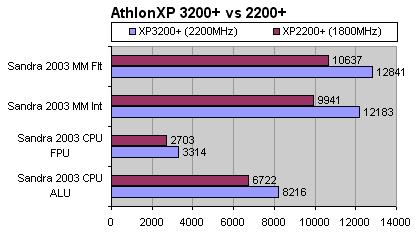
Here, the highest difference is in the CPU - FPU benchmark, with the 3200+ some 22.6% faster than the 2200+. This is impressive, but only in line with what we'd expect from the core speed rise. These benchmarks are heavily dependant on core speed, so we'll continue on.
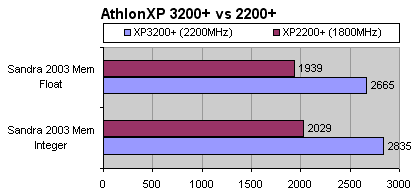
In the memory bandwidth benchmark we see a huge jump, 37.9%. The higher core speed is obviously complements the benefits of the higher bandwidth across the FSB. We demonstrated earlier than simply raising the FSB alone gave a noticeable memory bandwidth jump.
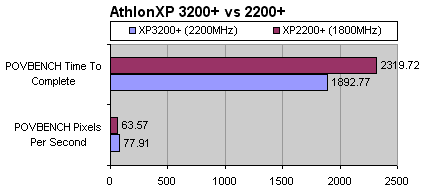
Remember that the top graph in the image above, LESS is better. In the bottom graph, MORE is better. POVBENCH is very CPU-intensive and unsurprisingly we see an increase of about 22.5% again, in direct correlation to the higher core speed. Our previous results show that the FSB and L2 size changes don't affect POVBENCH much and we see that here again.
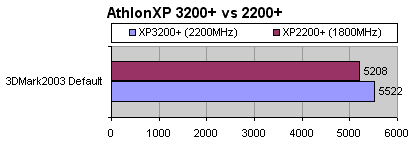
In 3DMark we see only a 6% increase. Of course, this benchmark is in some cases limited by other components such as the AGP bus. It's also likely that in sections we are maxing out the video card, even though it's the current king, ATI's Radeon 9800 Pro.
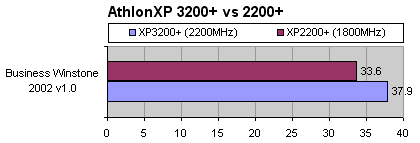
In this benchmark of common workstation tasks the jump is a mere 12.8%. That's less than we would expect, given the increase in core MHz. However, Winstone is a complex benchmark with many components, with a varying dependence on CPU power and different weightings towards the final score. I also suspect the scores are not something you can compare as linearly as the others such as 3DMark or POVBENCH.
Performance Conclusions
Well, after pages of graphs, there's a bit of thinking to be done. AMD have been accused of marketing trickery with their Performance Rating system, which uses numbers like 3200+ instead of sheer MHz to describe a CPU. I have defended this system, because I know that sheer MHz is not an accurate way of judging CPU performance. However, I think in this instance the 3200+ title is misleading. If we assume PR is a linear scale, which most consumers will, it implies a 45% speed jump over 2200+. The speed jump from this older CPU is not as dramatic as the PR system suggests. I think AMD have slightly painted themselves into a corner, with 2500+, 2800+ and 3000+ already available, they had to list this as 3200+ simply to be seen as making progress. I wonder if the next increment, presumably 3400+ or 3500+, will be an even smaller step forward in terms of demonstrable performance or if it will accurately represent a larger speed increase.
|
|
Advertisement:
All original content copyright James Rolfe.
All rights reserved. No reproduction allowed without written permission.
Interested in advertising on OCAU? Contact us for info.
|

|


